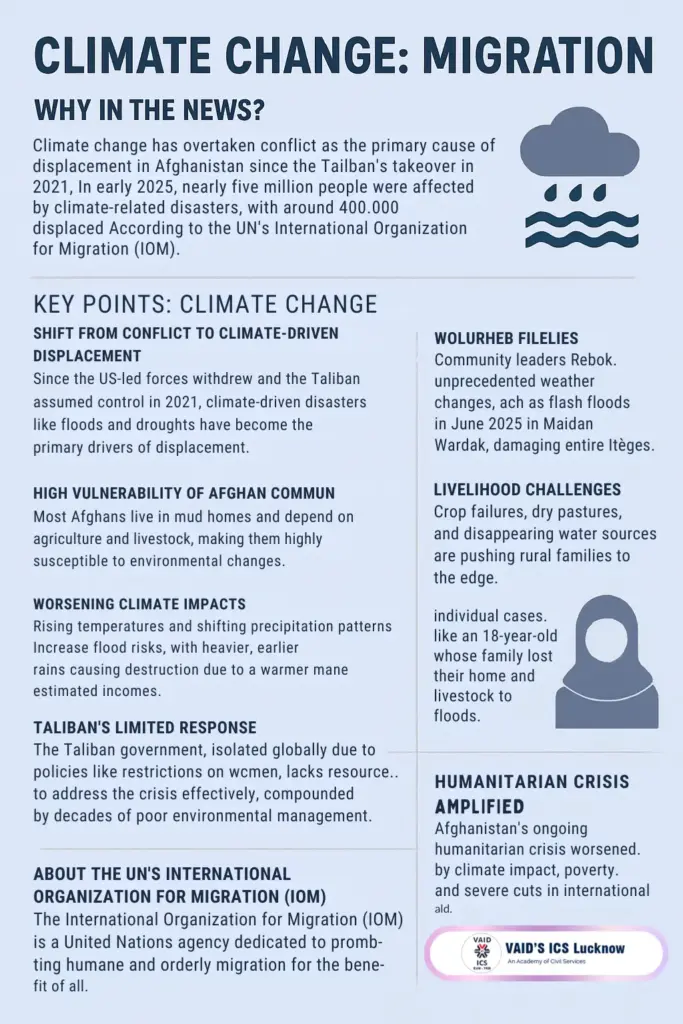August 21, 2025
Climate Change : Migration
Why in the News?
Climate change has overtaken conflict as the primary cause of displacement in Afghanistan since the Taliban’s takeover in 2021. In early 2025, nearly five million people were affected by climate-related disasters, with around 400,000 displaced, according to the UN’s International Organization for Migration (IOM).

Key Points: Climate Change
- Shift from Conflict to Climate-Driven Displacement:
- Since the US-led forces withdrew and the Taliban assumed control in 2021, climate-driven disasters like floods and droughts have become the primary drivers of displacement.
- By early 2025, climate-related disasters affected around five million Afghans, forcing about 400,000 to leave their homes.
- High Vulnerability of Afghan Communities:
- Most Afghans live in mud homes and depend on agriculture and livestock, making them highly susceptible to environmental changes.
- The country faces its fourth drought in five years, alongside flash floods that destroy homes, crops, and livelihoods.
- Worsening Climate Impacts:
- Rising temperatures and shifting precipitation patterns increase flood risks, with heavier, earlier rains causing destruction due to a warmer atmosphere holding more water.
- Community leaders report unprecedented weather changes, such as flash floods in June 2025 in Maidan Wardak, damaging entire villages.
- Livelihood Challenges:
- Crop failures, dry pastures, and disappearing water sources are pushing rural families to the edge, making it difficult to grow food or sustain incomes.
- Individual cases, like an 18-year-old whose family lost their home and livestock to floods, highlight the personal toll of these disasters.
- Taliban’s Limited Response:
- The Taliban government, isolated globally due to policies like restrictions on women, lacks resources to address the crisis effectively, compounded by decades of poor environmental management.
- The Energy and Water Minister admitted in July 2025 that planned dam and canal projects are insufficient, often attributing droughts to divine will and relying on prayers for rain.
- Humanitarian Crisis Amplified:
- Afghanistan’s ongoing humanitarian crisis is worsened by climate impacts, poverty, and severe cuts in international aid.
- Limited infrastructure and resources hinder the country’s ability to adapt to or recover from environmental disasters.
About the UN’s International Organization for Migration (IOM)
- The International Organization for Migration (IOM) is a United Nations agency dedicated to promoting humane and orderly migration for the benefit of all.
- Established in 1951, it works to address migration challenges, provide assistance to migrants, and support governments in managing migration effectively.
- In the context of Afghanistan, as highlighted in the provided article, the IOM plays a critical role in tracking and addressing climate-induced displacement, assessing vulnerabilities, and delivering humanitarian aid.
Daily Gist of The Hindu/Indian Express: 6 Oct 2025
October 6, 2025
Daily Gist of Article /The Hindu /Indian Express: 24 Sep 2025
September 24, 2025
Gist of Daily News Papers Articles/The Hindu /Indian Express-23 Sep 2025
September 23, 2025
Daily Article Gist/The Hindu/22 Sep 2025
September 22, 2025

